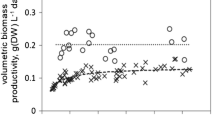Abstract
A sand-zeolite culture system simulating plant acquisition of K from soils has been developed. The system, a mixture of synthetic zeolite IE-96 and coarse-sand, provides K concentrations comparable to soils depending on the K concentration ratios of solutions loaded onto the cation-exchange sites of the zeolite and the ionic strengths of the nutrient solutions supplied during the period of plant growth. Tomato (Lycopersicon esculentum Mill.) strain 203, PI 124163, was used in this study. An increase in the amount of the loaded zeolite per culture pot did not shift solution phase K activity ratios (ARk) of the culture system but did result in a linear increase of plant dry matter accumulation, indicating that K bioavailability is diffusion-limited in the sand-zeolite culture system as in soils.
Similar content being viewed by others
References
AdamsF 1971 Ionic concentrations and activities in soil solutions. Soil Sci. Soc. Amer. Proc. 35, 420–426.
BarberS A 1981 Soil chemistry and the availability of plant nutrients. In Chemistry in the Soil Environment. Eds. D EBaker, J ARyan and V VVolk. pp 1–12. American Society of Agronomy, Spec. Pub. 40. Madison, WI.
BarberS A 1984 Soil Nutrient Bioavailability: A Mechanistic Approach. Wiley, New York. 389 p.
BeckettP H T 1964a Studies on soil potassium I. Confirmation of ratio law: Measurement of potassium potential. J. Soil Sci. 15, 1–8.
BeckettP H T 1964b Studies on soil potassium II. The immediate Q/I relation of labile potassium in the soil. J. Soil Sci. 15, 9–23.
BreckD W 1974 Zeolite Molecular Sieves: Structure, Chemistry and Use. Wiley, New York. 535p.
ColtmanR R, GerloffG C and GabelmanW H 1982 A sand culture system for simulating plant responses to phosphorus in soil. J. Am. Soc. Hort. Sci. 107, 938–942.
FigdoreS S, GabelmanW H and GerloffG C 1987 The accumulation and distribution of sodium in tomato strains differing in potassium efficiency when grown under low-K stress. In Genetic Aspects of Plant Mineral Nutrition. Eds. W HGabelman and B CLoughman. pp 353–360. Martinus Nijhoff Publishers, Dordrecht, The Netherlands.
GerloffG C 1987 Intact-plant screening for tolerance of nutrient-deficiency stress. Plant and Soil 99, 3–16.
MatthewsB C and BeckettP H T 1962 A new procedure for studying the release and fixation of potassium ion in soil. J. Agric. Sci. 58, 59–64.
MengelK and KirkbyE A 1982 Principles of Plant Nutrition 3th edition. International Potash Institute, Bern, Switzerland, pp 54–61.
MossP 1967 Independence of soil quantity/intensity relationship to changes in exchangeable potassium: Similar potassium exchange constants for soil within a soil type. Soil Sci. 103, 196–201.
NafadyM H and LammC G 1973 Plant availability in soil. IV. The effects of K fixation on quantity/intensity relationship, with reference to factors affecting the rate of capacity of potassium fixation and the corresponding changes in soil cation exchange capacity. Agrichimica 17, 307–315.
NewsamJ M 1986 The zeolite cage structure. Science 231, 1093–1099.
NyeP H 1977 The rate-limiting step in plant nutrient absorption from soil. Soil Sci. 123, 292–297.
RussellE W 1973 Soil Conditions and Plant Growth, 10th edition. Longman, London, UK, 849 p.
SchofieldR K 1947 A ratio law governing the equilibrium of cations in solution Proc. 11th Int. Congr. Pure and Appl. Chem. London. 3, 257–261.
SemmensM J 1984 Cation-exchange properties of natural zeolites. In Zeo-Agriculture: Use of Natural Zeolites in Agriculture and Aquiculture. Eds. W GPond and F AMumption. pp 45–53. Westview Press, Boulder, CO.
Sherman J D 1978 Ion exchange separations with molecular sieve zeolites. In Adosorption and Ion Exchange Separations. Ed. J D Sherman. pp 98–116. A. I. Ch. E. Symp. Series, 74, No. 179.
SmithJ V 1984 Definition of zeolite. Zeolites. 4, 309–310.
SpositoG 1981 The Thermodynamics of Soil Solutions. Oxford, Clarendon Press. 233p.
Author information
Authors and Affiliations
Rights and permissions
About this article
Cite this article
Chen, J., Gabelman, W.H. A sand-zeolite culture system for simulating plant acquisition of potassium from soils. Plant Soil 126, 169–176 (1990). https://doi.org/10.1007/BF00012820
Received:
Issue Date:
DOI: https://doi.org/10.1007/BF00012820




